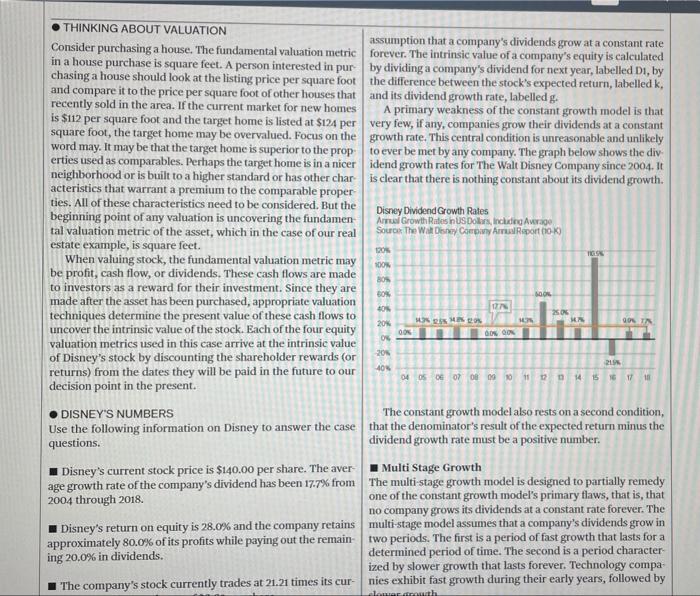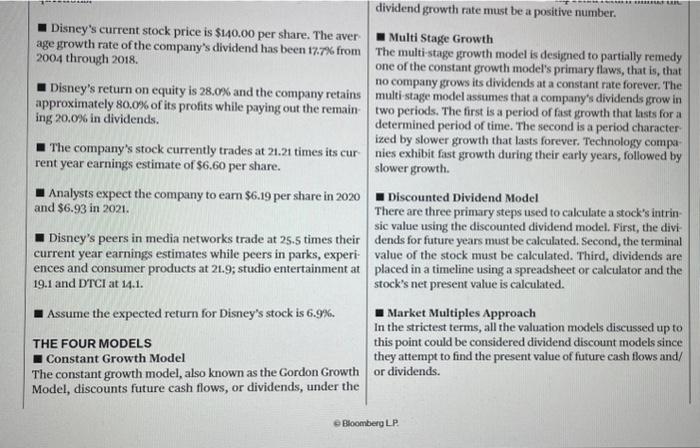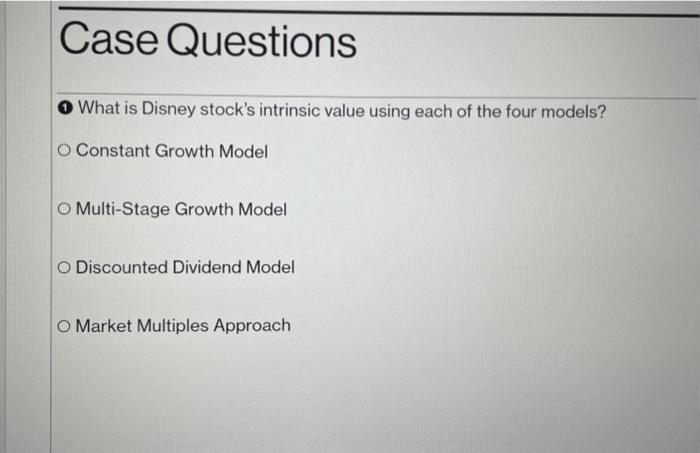Eauity Analysis and Valuation Understand and compare the theoretical equity valuation methods Disnoy Segment Revenues and Operating income to the more commonly-used multiple valuation approach, and then apply these tools to value a company. This supplement explores the reasoning behind and the disadvantages of the three theoretical equity valuation models-constant growth model, multi-stage growth model, and dividend discount model-by comparing them to the most frequently-used market multiple valuation approach through the lens of General Electric (CE). Subsequently, we will do the same valuations and comparisons with The Walt Disney Company (Disney) for homework. HOW DISNEY MAKES MONEY Disney has four operating segments: Media Networks, Parks, Experiences \& Consumer Products, Studio Entertainment, and Direct-to-Consumer \& International. The table shows the proportion of Disney's total revenues and operating income that come from each segment. THINKING ABOUT VALUATION in a house purchase is square feet. A person interested in pur- by dividing a company's dividend for next year, labelled Di, by chasing a house should look at the listing price per square foot the difference between the stock's expected return, labelled k, and compare it to the price per square foot of other houses that and its dividend growth rate, labelled g. recently sold in the area. If the current market for new homes _ A primary weakness of the constant growth model is that is $112 per square foot and the target home is listed at $124 per very few, if any, companies grow their dividends at a constant square foot, the target home may be overvalued. Focus on the growth rate. This central condition is unreasonable and unlikely word may. It may be that the target home is superior to the prop: to ever be met by any company. The graph below shows the div. erties used as comparables. Perhaps the target home is in a nicer idend growth rates for The Walt Disney Company since 2004. It neighborhood or is built to a higher standard or has other char- is clear that there is nothing constant about its dividend growth. acteristics that warrant a premium to the comparable properties. All of these characteristics need to be considered. But the beginning point of any valuation is uncovering the fundamental valuation metric of the asset, which in the case of our real Disney Dividend Growth Rales estate example, is square feet. When valuing stock, the fundamental valuation metric may be profit, cash flow, or dividends. These cash flows are made to investors as a reward for their investment. Since they are made after the asset has been purchased, appropriate valuation techniques determine the present value of these cash flows to uncover the intrinsic value of the stock. Each of the four equity valuation metrics used in this case arrive at the intrinsic value of Disney's stock by discounting the shareholder rewards (or returns) from the dates they will be paid in the future to our decision point in the present. DISNEY'S NUMBERS The constant growth model also rests on a second condition, Use the following information on Disney to answer the case that the denominator's result of the expected return minus the questions. dividend growth rate must be a positive number. - Disney's current stock price is $140.00 per share. The aver- Multi Stage Growth age growth rate of the company's dividend has been 17.7% from The multi-stage growth model is designed to partially remedy 2004 through 2018. one of the constant growth model's primary flaws, that is, that no company grows its dividends at a constant rate forever. The - Disney's return on equity is 28.0% and the company retains multi-stage model assumes that a company's dividends grow in approximately 80.0% of its profits while paying out the remain- two periods. The first is a period of fast growth that lasts for a ing 20.0% in dividends. determined period of time. The second is a period character- - The company's stock currently trades at 21.21 times its curized by slower growth that lasts forever. Technology companies exhibit fast growth during their early years, followed by Disney's current stock price is $140.00 per share. The aver age growth rate of the company's dividend has been 17.7% from The multi-stage growth model is designed to partially remedy 2004 through 2018. one of the constant growth model's primary flaws, that is, that no company grows its dividends at a constant rate forever. The - Disney's return on equity is 28.0% and the company retains multi-stage model assumes that a company's dividends grow in approximately 80.0% of its profits while paying out the remain. two periods. The first is a period of fast growth that lasts for a ing 20.0% in dividends. determined period of time. The second is a period characterized by slower growth that lasts forever. Technology compa- The company's stock currently trades at 21.21 times its cur- nies exhibit fast growth during their early years, followed by rent year earnings estimate of $6.60 per share. slower growth. - Analysts expect the company to earn $6.19 per share in 2020 - Discounted Dividend Model and $6.93 in 2021. There are three primary steps used to calculate a stock's intrinsic value using the discounted dividend model. First, the divi- Disney's peers in media networks trade at 25.5 times their dends for future years must be calculated. Second, the terminal current year earnings estimates while peers in parks, experi- value of the stock must be calculated. Third, dividends are ences and consumer products at 2L.9; studio entertainment at placed in a timeline using a spreadsheet or calculator and the 19.1 and DTCI at 14.1. stock's net present value is calculated. Assume the expected return for Disney's stock is 6.97. - Market Multiples Approach THE FOUR MODELS In the strictest terms, all the valuation models discussed up to - Constant Growth Model this point could be considered dividend discount models since The constant growth model, also known as the Gordon Growth or dividends. Model, discounts future cash flows, or dividends, under the What is Disney stock's intrinsic value using each of the four models? Constant Growth Model Multi-Stage Growth Model Discounted Dividend Model Market Multiples Approach (2) Reconcile Disney stock's intrinsic value, considering the strengths and weaknesses of each valuation approach











